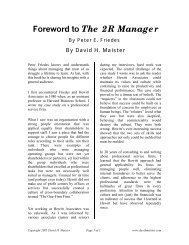pdf version - David Maister
pdf version - David Maister
pdf version - David Maister
You also want an ePaper? Increase the reach of your titles
YUMPU automatically turns print PDFs into web optimized ePapers that Google loves.
The Anatomy of a Consulting Firm<br />
percent, or the equivalent of three<br />
seniors working full-time. This implies<br />
six projects if the typical project requires<br />
50 percent of a senior’s time.<br />
With six projects, the firm needs the<br />
equivalent of six full-time middle-level<br />
staff according to the project team<br />
structure. (Each project requires 100<br />
percent of a middle-level person’s time.)<br />
At 75 percent target utilization (billed<br />
hours divided by available hours), this<br />
means that the firm must have eight<br />
middle-level staff (6 × 0.75). Similarly,<br />
at three juniors per project, the firm<br />
needs 18 full-time juniors (at 90 percent<br />
billability, that means 20 juniors).<br />
Simple calculations such as these show<br />
that, with eight seniors, the firm would<br />
need 16 managers and 40 juniors. The<br />
proportions remain constant: one senior<br />
to every two managers and every five<br />
juniors. Unless there is a change in either<br />
the project team structure (e.g., the types<br />
of projects the firm undertakes) or the<br />
target utilization (matters that will be<br />
discussed below), the firm must keep<br />
these ratios constant as it grows.<br />
This seemingly simple-minded<br />
calculation relating the staffing mix<br />
requirements of the work to the staffing<br />
levels existing in the firm is in fact of<br />
extreme importance.<br />
If we know the salaries of the staff<br />
members and their billing rates, we can<br />
construct the pro forma income<br />
statement of this firm at full utilization.<br />
(Figure 3)<br />
The role of leverage is amply illustrated<br />
by Guru Associates. The four seniors<br />
(partners) personally bill a total of<br />
$1,200,000, or $300,000 each. At perprofessional<br />
overhead costs of $40,000<br />
(including the costs of all secretaries,<br />
administrative staff, space, supplies,<br />
etc.), this would result in a per-partner<br />
profit of $260,000 if these seniors were<br />
totally unleveraged.<br />
With a healthy seven staff members per<br />
senior, partner profits now total<br />
$420,000 each. About 60 percent of each<br />
partner’s profit comes not from what he<br />
or she bills but from the profit generated<br />
by the nonpartner group. Thus the<br />
benefits of leverage!<br />
It should be immediately stressed that<br />
high leverage is not always good. As we<br />
have already observed, having high<br />
leverage is completely inappropriate if<br />
the firm has a high level of Brain<br />
Surgery or Psychotherapy work. What<br />
we can say is that leverage should be as<br />
high as the requirements of the work<br />
allow.<br />
We now turn to Guru Associates’<br />
position in the market for staff. Guru<br />
Associates has the following promotion<br />
policies: It considers that it requires four<br />
years for a junior to acquire the expertise<br />
and experience to perform the middlelevel<br />
function, and it expects to promote<br />
80 percent of its candidates to this<br />
position. A lower percentage would be<br />
insufficient to attract new juniors, and a<br />
higher percentage would imply that<br />
insufficient screening was taking place<br />
(i.e., that there was no room for hiring<br />
mistakes). From middle level to senior is<br />
also expected to take four years, but<br />
because fewer candidates develop the<br />
critical client relations skills that Guru<br />
Associates requires, on average only 50<br />
percent of the candidates make it.<br />
We shall now trace the evolution of<br />
Guru Associates over time. Among the<br />
eight middle-level staff, we may assume<br />
that, since it takes four years to make<br />
senior, in any given year there are onequarter<br />
(i.e., two) of these managers in<br />
their final year as middle-level staff. If<br />
Copyright 2005 <strong>David</strong> H. <strong>Maister</strong> Page 9 of 9 www.davidmaister.com











